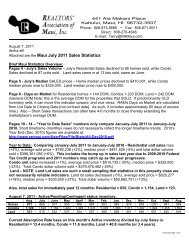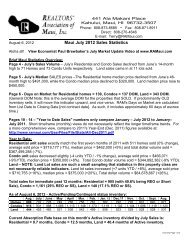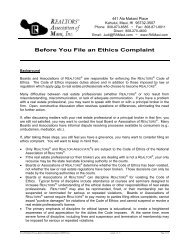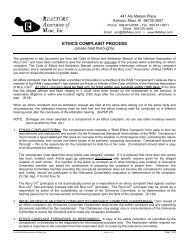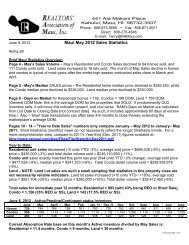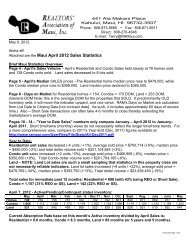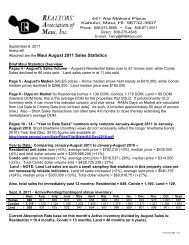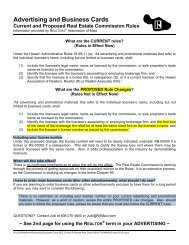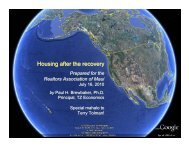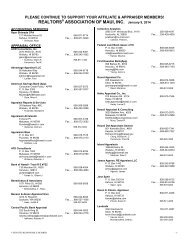125 page Presentation - REALTORS® Association of Maui, Inc.
125 page Presentation - REALTORS® Association of Maui, Inc.
125 page Presentation - REALTORS® Association of Maui, Inc.
You also want an ePaper? Increase the reach of your titles
YUMPU automatically turns print PDFs into web optimized ePapers that Google loves.
Prepared for the<br />
Realtors <strong>Association</strong> <strong>of</strong> <strong>Maui</strong><br />
July 8, 2011<br />
by Paul H. Brewbaker,<br />
Principal, TZ Economics<br />
<strong>Maui</strong> Housing: Double-Dip?<br />
Dip?<br />
Single-dip, and this is IT!<br />
Copyright 2011<br />
Paul H. Brewbaker, Ph.D.
Where is Hawaii in the cycle?<br />
Slide copyright 2011, TZ Economics<br />
1
Extracting the underlying trend from seasonally-<br />
adjusted data clearly reveals recession/recovery cycle<br />
Monthly, in million $, s.a., (log scale)<br />
140<br />
120<br />
100<br />
80<br />
GE tax (right scale)<br />
WH on wages (left)<br />
U.S. recessions shaded<br />
200<br />
100<br />
Monthly, in million $, s.a., (log scale)<br />
00 02 04 06 08 10<br />
Slide copyright 2011, TZ Economics<br />
Sources: Hawaii DoTAX, DBEDT; smoothing using Hodrick-Prescott filter by TZE<br />
2
Extracting the signal from the noise (through May):<br />
Hawaii general fund revenue is in cyclical recovery*<br />
Monthly in million $, s.a., log scale<br />
400<br />
300<br />
200<br />
*So stop acting like it isn’t<br />
02 03 04 05 06 07 08 09 10 11 12<br />
Slide copyright 2011, TZ Economics<br />
Sources: Hawaii DBEDT, DLIR; seasonal adjustment using Census X-12 ARIMA filter and Hodrick-Prescott filter extraction<br />
<strong>of</strong> private employment trend by TZE<br />
3
Home price indexes: long-term housing returns are<br />
equated by arbitrage, but supply constraints<br />
amplify Hawaii’s s valuation cycle<br />
Index, 1985Q1 = 100, s.a., log scale<br />
400<br />
200<br />
100<br />
50<br />
Hawaii<br />
Iowa<br />
Colorado<br />
U.S. recessions shaded<br />
80 85 90 95 00 05 10 15<br />
Restricting development only<br />
increases the amplitude <strong>of</strong><br />
the home price valuation<br />
cycle and makes life better for<br />
high net-worth real estate<br />
investors who can carry<br />
wealth through the trough<br />
Slide copyright 2011, TZ Economics<br />
Sources: Federal Housing Finance Agency (http://www.fhfa.gov/Default.aspx?Page=87) from sales prices and<br />
appraisals; seasonal adjustment, index rebasing and regression by TZ Economics<br />
4
The cycle in production (homebuilding)—new new units—Hawaii<br />
and U.S.; is there such a glut <strong>of</strong> housing in Hawaii?<br />
4.0<br />
4.0<br />
Quarterly, thousand units, s.a., log scale<br />
2.0<br />
1.0<br />
0.5<br />
Hawaii<br />
U.S.<br />
2.0<br />
1.0<br />
0.5<br />
80 85 90 95 00 05 10 15<br />
Quarterly, million units, s.a.a.r., log scale<br />
Slide copyright 2011, TZ Economics<br />
Sources: Federal Reserve Bank <strong>of</strong> St. Louis (http://research.stlouisfed.org/fred2/series/HOUST/downloaddata?cid=32302),<br />
Hawaii DBEDT, County Building Departments; seasonal adjustment and trend extract <strong>of</strong> Hawaii data by TZE<br />
5
Make the appropriate macroeconomic comparisons<br />
across space and time: what stands out?<br />
• This is not the mainland (duh) so don’t act as if everything that happens<br />
there matters here<br />
• Which is more relevant to Hawaii: the NBC Nightly News (KHNL TV) or<br />
the news from NHK Tokyo (Hawaii Public Television)? Which gets more<br />
viewers?<br />
• Hawaii’s economic experience is dichotomous: Oahu and the Neighbor<br />
Islands have had different Great Recession outcomes<br />
Slide copyright 2011, TZ Economics<br />
6
Real Hawaii personal income indexed to last three<br />
cyclical peaks: this recession was not Hawaii’s s worst<br />
110<br />
P T<br />
Index, cyclical peak = 100 (log scale)<br />
105<br />
100<br />
95<br />
90<br />
Peak 1980<br />
Peak 1993<br />
Peak 2007<br />
US peak(07)<br />
Great Recession<br />
(t − 2) (t − 1) t 0<br />
(t + 1) (t + 2)<br />
Years<br />
Current<br />
recovery<br />
so-so<br />
Slide copyright 2011, TZ Economics<br />
Sources:<br />
BEA, BLS ; deflation and indexation by TZE<br />
7
Real personal income by county (indexed to 2007<br />
level—no 2010 data yet) Neighbor Islands hurting<br />
102<br />
Index, 2007 = 100, log scale<br />
100<br />
98<br />
96<br />
94<br />
<strong>Maui</strong><br />
OAHU<br />
U.S.<br />
HAWAII<br />
KAUAI<br />
MAUI<br />
92<br />
05 06 07 08 09 10<br />
Sources:<br />
BEA, BLS ; deflation and indexation by TZE<br />
Slide copyright 2011, TZ Economics<br />
8
Hawaii private sector jobs: recovery is proceeding…<br />
520<br />
P T<br />
Thousands, s.a., log scale<br />
510<br />
500<br />
490<br />
480<br />
470<br />
460<br />
2.7% Quarterly<br />
annualized growth<br />
<strong>of</strong> trend component<br />
(actual data: 2.6%)<br />
2.4% Semiannual<br />
annualized growth<br />
<strong>of</strong> trend component<br />
(actual data: 2.7%)<br />
450<br />
U.S. recession shaded<br />
04 05 06 07 08 09 10 11<br />
Slide copyright 2011, TZ Economics<br />
Sources: Hawaii DBEDT, DLIR; seasonal adjustment using Census X-12 ARIMA filter and Hodrick-Prescott filter extraction<br />
<strong>of</strong> private employment trend by TZE<br />
9
…but only on Oahu: total private + public jobs<br />
⇒ Neighbor Islands are not participating<br />
Oahu (right scale)<br />
180<br />
Neighbor Isle (left)<br />
P T<br />
460<br />
Thousands, s.a., log scale<br />
175<br />
170<br />
165<br />
160<br />
155<br />
450<br />
440<br />
430<br />
420<br />
Thousands, s.a., log scale<br />
150<br />
U.S. recession shaded<br />
03 04 05 06 07 08 09 10 11 12<br />
410<br />
Slide copyright 2011, TZ Economics<br />
Sources: Hawaii DBEDT, DLIR; seasonal adjustment using Census X-12 ARIMA filter and Hodrick-Prescott filter extraction<br />
<strong>of</strong> private employment trend by TZE<br />
10
Monthly unemployment rates:<br />
Oahu its own private Idaho<br />
Thousands, s.a., log scale<br />
12<br />
10<br />
8<br />
6<br />
4<br />
2<br />
U.S.<br />
Neighbor Isle<br />
Statewide<br />
Oahu<br />
P T<br />
9.1% U.S.<br />
8.4% Neighbor Isle<br />
5.9% Statewide (5.6% BLS)<br />
4.9% Oahu<br />
0<br />
U.S. recessions shaded<br />
04 05 06 07 08 09 10 11<br />
Slide copyright 2011, TZ Economics<br />
Sources: U.S. BLS, Hawaii DBEDT, DLIR; seasonal adjustment <strong>of</strong> Hawaii data using Census X-12 ARIMA filter by TZE<br />
11
The business cycle varies across time and space<br />
• The Great Recession was the worst U.S. recession since the Great<br />
Depression<br />
• The Great Recession was not the worst Hawaii recession<br />
• Hawaii’s early-1980s recession(s) was (were) deeper<br />
• Hawaii’s early-1990s recession was longer<br />
• Hawaii’s dot.com recession <strong>of</strong> 2001 wasn’t<br />
• Hawaii’s private sector jobs recovery is underway<br />
• Hawaii’s public sector job los was a deliberate “9/11” event<br />
• By a variety <strong>of</strong> measures Oahu is in far better shape than the mainland<br />
and the Neighbor Island essentially are the mainland<br />
Waiting for labor shortages and until after there is no inventory is too long<br />
Slide copyright 2011, TZ Economics<br />
12
A diversion: double-dips dips in the news<br />
Slide copyright 2011, TZ Economics<br />
13
Yikes!<br />
Scary headline!<br />
Slide copyright 2011, TZ Economics<br />
Source: Newsmax Wires (May 31, 2011), http://www.newsmax.com/Headline/housing-economy-foreclosuresrecession/2011/05/31/id/398297<br />
14
On the<br />
home<br />
front<br />
Honolulu Star-Advertiser (July 8, 2011)<br />
http://www.staradvertiser.com/news/20110708_<br />
Oahu_home_sales_relapse.html<br />
Slide copyright 2011, TZ Economics<br />
15
Logistic growth function, k = 100, r = 0.10 and r = 1.9<br />
120<br />
100<br />
80<br />
Crunchy-granola bliss<br />
120<br />
100<br />
80<br />
x(t)<br />
60<br />
x(t)<br />
60<br />
40<br />
40<br />
20<br />
0<br />
r = 0.10<br />
20<br />
r = 1.9<br />
0<br />
1 21 41 61 81 101 121<br />
1 21 41 61<br />
t (time)<br />
t (time)<br />
A population with a carrying capacity <strong>of</strong> k = 100 growing at a logistic<br />
growth rate <strong>of</strong> 10%, converges smoothly (left panel); a higher intrinsic<br />
growth rate yields more rapid, oscillatory convergence (right panel).<br />
Slide copyright 2011, TZ Economics<br />
16
A made-up asset price trajectory displaying oscillatory<br />
convergence—higher<br />
“intensity” implies “wobbliness”<br />
p(t) (thousand $)<br />
650<br />
600<br />
550<br />
500<br />
450<br />
400<br />
350<br />
Period 1 equilibrium price: $350,000<br />
Period n equilibrium price: $600,000*<br />
(for example, assume that purchasing<br />
power limits the median household’s<br />
“carrying capacity” to the latter price)<br />
Oahu median<br />
SF home prices<br />
300<br />
*Uses Micros<strong>of</strong>t Excel’s built-in graphics<br />
smoothing algorithm applied to a logistic<br />
growth function with intrinsic growth rate<br />
<strong>of</strong> 1.5 and carrying capacity <strong>of</strong> 600<br />
0 5 10<br />
t (years)<br />
Slide copyright 2011, TZ Economics<br />
17
Look familiar? Oahu single-family median home<br />
prices from 2003 through May 2011<br />
700<br />
Thousand $, s.a., log scale<br />
650<br />
600<br />
550<br />
500<br />
450<br />
400<br />
“Double-dip?” or<br />
oscillatory<br />
convergence?<br />
350<br />
03 04 05 06 07 08 09 10 11<br />
Slide copyright 2011, TZ Economics<br />
Sources: Honolulu Board <strong>of</strong> Realtors; seasonal adjustment using Census X-12 filter and Hodrick-Prescott filter trend<br />
extraction by TZ Economics<br />
18
More complex asset price adjustment paths: an<br />
overshooting model <strong>of</strong> asset price decline<br />
Simulated asset price dynamics in a model<br />
<strong>of</strong> “slow-moving capital” by Darrel Duffie<br />
“The key implication is that supply or demand shocks must be absorbed on<br />
short notice by a limited set <strong>of</strong> investors. The risk aversion or limited<br />
capital <strong>of</strong> the currently available investors, including intermediaries, leads<br />
them to require a price concession in order to absorb the supply or demand<br />
shock. They plan to ‘lay <strong>of</strong>f’ the associated risk over time as other<br />
investors become available. As a result, the initial price impact is followed<br />
by a price reversal that may occur over an extended period <strong>of</strong> time.”<br />
Slide copyright 2011, TZ Economics<br />
Source: Darrell Duffie, “Asset Price Dynamics with Slow-Moving Capital” Journal <strong>of</strong> Finance vol. 65 no. 4 (August 2010)<br />
pp 1239-1267 (http://www.darrellduffie.com/uploads/pubs/DuffieAFAPresidentialAddress2010.pdf)<br />
19
Meltdown after 2006: overshooting plus oscillation<br />
in S&P Case-Shiller<br />
home price indexes<br />
280<br />
January 2000 = 100 s.a., log scale<br />
240<br />
200<br />
160<br />
120<br />
Los Angeles<br />
San Diego<br />
San Francisco<br />
Las Vegas<br />
LAX<br />
SAN<br />
SFO<br />
LAS<br />
Is this a “double-dip?”<br />
or is this overshooting<br />
followed by oscillatory<br />
convergence?<br />
This is Vegas, baby<br />
80<br />
03 04 05 06 07 08 09 10 11<br />
Slide copyright 2011, TZ Economics<br />
Sources: Standard & Poor’s; seasonal adjustment using Census X-12 filter by TZ Economics<br />
20
S&P 500 daily closing values:<br />
post-Lehman overshooting,<br />
uneven recovery<br />
1600<br />
1400<br />
Lehman Brothers collapses<br />
(September 15, 2008)<br />
Index, 1941-43 = 10<br />
1200<br />
1000<br />
800<br />
600<br />
NBER recession shaded<br />
(March 9, 2009)<br />
2007 2008 2009 2010 2011<br />
Slide copyright 2011, TZ Economics<br />
Sources: Standard & Poor’s, Federal Reserve Bank <strong>of</strong> St. Louis; daily closing data through June 22, 2011<br />
21
Intra-day S&P 500 May 6, 2010 “Flash Crash”<br />
time domain: intraday<br />
−8.5%<br />
Slide copyright 2011, TZ Economics<br />
Source: http://www.marketoracle.co.uk/images/2010/Jun/flash-crash-4-2.jpg<br />
22
Kauai visitor arrivals, hurricane Iniki etc.,<br />
time domain: half a decade<br />
160<br />
Monthly in thousands, s.a., log scale<br />
80<br />
40<br />
20<br />
Gulf<br />
War<br />
Iniki<br />
Iraqnaphobia*<br />
9/11 90 92 94 96 98 00 02 04<br />
Slide copyright 2011, TZ Economics<br />
Sources: Hawaii DBEDT; Bank <strong>of</strong> Hawaii; *semantic mahalo to Diane Swonk, Mesirow Finance<br />
23
Hawaii international arrivals variation in monthly<br />
standard deviations under four exogenous shocks<br />
“3-6 months” “3-6 months”<br />
2<br />
Kobe<br />
2<br />
1<br />
0<br />
-1<br />
Gulf War<br />
1<br />
0<br />
-1<br />
SARS<br />
9/11<br />
-2<br />
-2<br />
-3<br />
-3<br />
Early-1990s: rising arrivals trend<br />
q 0<br />
q 1<br />
q 2<br />
q 3<br />
q 0<br />
q 1<br />
q 2<br />
q 3<br />
Early-2000s: falling arrivals trend<br />
Slide copyright 2011, TZ Economics<br />
Sources: Arrivals data published by HTA and DBEDT; interval standard deviation estimates relative to 4.5–year trends<br />
by TZ Economics<br />
24
Hawaii daily passenger arrivals on flights from<br />
Japan—difference from this year to last<br />
Thousands per day, net<br />
(2011 minus 2010)<br />
2<br />
1<br />
0<br />
-1<br />
-2<br />
-3<br />
Sendai seismic<br />
event (March 11)<br />
-4<br />
10.12 11.01 11.02 11.03 11.04 11.05 11.06<br />
Slide copyright 2011, TZ Economics<br />
Source: Hawaii DBEDT; calculations on daily passenger counts by TZ Economics through June 7, 2011<br />
25
Double-dip your home price<br />
• A “double-dip” in asset valuations could just be somebody’s way <strong>of</strong><br />
scaring the crap out <strong>of</strong> you so you’ll “tune in tomorrow”*<br />
• Or it could be the norm—complexity<br />
• You’re surrounded by exogenous impulses<br />
• These shocks generate complex paths: overshooting, oscillation, many<br />
different convergence trajectories from one equilibrium to another<br />
• Asset price dynamics—for stocks, bonds, commodities, houses—all<br />
exhibit these movements; it’s happening right now<br />
*See NBC Nightly News, Friday, July 8, 2011: http://www.msnbc.msn.com/id/3032619/vp/43691544#43691544<br />
(fast-forward to 1:11 in the clip)<br />
Slide copyright 2011, TZ Economics<br />
26
Two decades <strong>of</strong> Oahu home prices: under the cycle<br />
lie varying forcing factors and complex dynamics<br />
• Long-term home prices gravitate to an appreciate trend dictated by longrun<br />
returns in alternative asset classes (via arbitrage—capital and<br />
occupants are both mobile)<br />
• Each valuation cycle has its own character; each cycle is associated<br />
with a particular asset price adjustment path from one equilibrium<br />
“before the boom” to another equilibrium “after the boom”<br />
• A variety <strong>of</strong> complex trajectories are possible, in the same market in<br />
different cycles, or in different markets in the same cycle (even when all<br />
markets face the same constellation <strong>of</strong> macroeconomic drivers)<br />
Slide copyright 2011, TZ Economics<br />
27
Long run Oahu SF home prices: arbitrage to risk-<br />
free asset return plus a risk premium and expected<br />
inflation premium (higher pre-1980, lower post-1980)<br />
1000<br />
Annual in thousand $, s.a. (log scale)<br />
100<br />
Know your inflation history: a trend break in<br />
U.S. inflationary momentum in 1980, when<br />
monetary policy regime change was initiated<br />
by Jimmy Carter’s appointment <strong>of</strong> Paul Volker<br />
Oahu mean SF price<br />
Trend pre-1980<br />
Trend post-1980<br />
1960 1970 1980 1990 2000 2010 2020<br />
Slide copyright 2011, TZ Economics<br />
Sources: Hawaii DBEDT, TZ Economics; regressions <strong>of</strong> natural logs <strong>of</strong> mean home prices on time trend 1958-1983 and<br />
1976-2010.<br />
28
In the 1990s, median Oahu condo and SF home<br />
prices fell: possible convergence paths generated<br />
by a logistic model (see Appendix 1)<br />
200<br />
150<br />
100<br />
50<br />
Calibrated to early-<br />
1990s Oahu condo<br />
price movements<br />
200<br />
150<br />
100<br />
50<br />
400<br />
350<br />
300<br />
250<br />
200<br />
Calibrated to early-<br />
1990s Oahu SF home<br />
price movements<br />
400<br />
350<br />
300<br />
250<br />
200<br />
Slide copyright 2011, TZ Economics<br />
29
The actual 1990s Oahu path: smooth compression<br />
220<br />
200<br />
180<br />
160<br />
140<br />
120<br />
Thousand $, s,a, (log scale)<br />
Thousand $, s,a, (log scale)<br />
400<br />
380<br />
360<br />
340<br />
320<br />
300<br />
280<br />
100<br />
End <strong>of</strong> U.S. recession shaded<br />
91 92 93 94 95 96 97 98 99 00<br />
260<br />
End <strong>of</strong> U.S. recession shaded<br />
91 92 93 94 95 96 97 98 99 00<br />
Median condo price<br />
Median single-family home price<br />
Slide copyright 2011, TZ Economics<br />
Sources: Honolulu Board <strong>of</strong> Realtors, Standard & Poor’s; seasonal adjustment using Census X-12 ARIMA filter and trend<br />
extraction using Hodrick-Prescott filter by TZE<br />
30
Median Oahu home prices: mid-1990s sag,<br />
2000s overshoot and oscillation<br />
700<br />
Thousand $, s.a. (log scale)<br />
400<br />
200<br />
Single-family (right scale)<br />
Condominium (left)<br />
600<br />
500<br />
400<br />
300<br />
200<br />
Thousand $, s.a. (log scale)<br />
U.S. recessions shaded<br />
100<br />
90 95 00 05 10<br />
Slide copyright 2011, TZ Economics<br />
Sources: Harvey Shapiro, Honolulu Board <strong>of</strong> Realtors; recession dates are NBER cyclical turning points (peak-trough);<br />
seasonal adjustment by TZE using Census X-12 ARIMA filter<br />
31
Median Oahu home prices: mid-1990s sag,<br />
2000s overshoot and oscillation<br />
700<br />
Thousand $, s.a. (log scale)<br />
400<br />
200<br />
After the 1994 Fed<br />
tightening: smooth<br />
convergence to lower<br />
equilibrium prices<br />
Late in the 2000s housing<br />
“bubble:” overshooting,<br />
oscillatory convergence<br />
600<br />
500<br />
400<br />
300<br />
Thousand $, s.a. (log scale)<br />
100<br />
90 95 00 05 10<br />
Slide copyright 2011, TZ Economics<br />
Sources: Harvey Shapiro, Honolulu Board <strong>of</strong> Realtors; recession dates are NBER cyclical turning points (peak-trough);<br />
seasonal adjustment by TZE using Census X-12 ARIMA filter<br />
32
This cycle’s s median existing single-family home<br />
prices: “double-dip” or overshooting + oscillation?<br />
900<br />
Quarterly, thousand $, s.a. (log scale)<br />
800<br />
700<br />
600<br />
500<br />
400<br />
300<br />
U.S. recession shaded<br />
2005 2006 2007 2008 2009 2010 2011<br />
San Jose, Sunnyvale, Santa Clara<br />
Oahu<br />
Anaheim, Santa Ana, Irvine<br />
San Francisco, Oakland, Fremont<br />
<strong>Maui</strong><br />
Los Angeles, Long Beach, Santa Ana<br />
San Diego, Carlsbad, San Marcos<br />
Slide copyright 2011, TZ Economics<br />
Sources: Honolulu Board <strong>of</strong> Realtors, Realtors <strong>Association</strong> <strong>of</strong> <strong>Maui</strong>, National <strong>Association</strong> <strong>of</strong> Realtors; seasonal<br />
adjustment by TZE using Census X-12 ARIMA filter<br />
33
All these markets faced the same interest rates,<br />
homebuyer tax credits; each has unique price path<br />
900<br />
800<br />
700<br />
600<br />
500<br />
Oahu<br />
900<br />
800<br />
700<br />
600<br />
500<br />
400<br />
400<br />
Orange County, CA<br />
800<br />
06 07 08 09 10 11 12<br />
800<br />
06 07 08 09 10 11 12<br />
700<br />
700<br />
600<br />
600<br />
San Diego<br />
500<br />
<strong>Maui</strong><br />
500<br />
400<br />
400<br />
300<br />
05 06 07 08 09 10 11 12<br />
300<br />
05 06 07 08 09 10 11 12<br />
Slide copyright 2011, TZ Economics<br />
34
<strong>Maui</strong> existing single-family home sales median prices<br />
now smoothly converging to the low- to mid-$400ks<br />
800<br />
Monthly, thousand $, s.a. (log scale)<br />
400<br />
200<br />
1995 2000 2005 2010 2015<br />
Pau by 2013? By<br />
“October 26, 2012?”<br />
Slide copyright 2011, TZ Economics<br />
Sources: Realtors <strong>Association</strong> <strong>of</strong> <strong>Maui</strong>; seasonal adjustment using Census X-12 ARIMA filter and trend extraction using<br />
Hodrick-Prescott filter by TZE<br />
35
<strong>Maui</strong> existing single-family home sales price<br />
distribution shifted to the left since the cyclical peak<br />
700<br />
Number <strong>of</strong> sales<br />
in $250,000 increments<br />
600<br />
500<br />
400<br />
300<br />
200<br />
100<br />
2006<br />
2010<br />
0<br />
0.0 0.5 1.0 1.5 2.0 2.5 3.0<br />
Million dollars<br />
Slide copyright 2011, TZ Economics<br />
Sources: Realtors <strong>Association</strong> <strong>of</strong> <strong>Maui</strong>; histogram generation by TZ Economics<br />
36
<strong>Maui</strong> existing-home days on market: not so much a<br />
glut <strong>of</strong> supply* as lackluster absorption<br />
Lehman<br />
Monthly, days, s.a. (log scale)<br />
200<br />
100<br />
Single-family<br />
Condominium<br />
Condo<br />
Single-family<br />
Recessions shaded<br />
02 04 06 08 10 12<br />
*Even with all those #@*^& foreclosures!<br />
Slide copyright 2011, TZ Economics<br />
Sources: Realtors <strong>Association</strong> <strong>of</strong> <strong>Maui</strong>; seasonal adjustment using Census X-12 ARIMA filter and trend extraction using<br />
Hodrick-Prescott filter by TZE<br />
37
<strong>Maui</strong> macroeconomic indicators: insufficient “lift, lift,”<br />
and self-inflicted wounds (“we(<br />
meant to do that”)<br />
• The legacy <strong>of</strong> the 2008 Aloha Airlines and ATA shutdowns still is felt in<br />
the relative lack <strong>of</strong> scheduled air seats to <strong>Maui</strong> from the mainland, and<br />
reduced interisland lift (Wiki: “Stackelberg competition”)*<br />
• Good timing on that fiscal austerity: no public job growth to complement<br />
the utter lack <strong>of</strong> private job growth<br />
• Unemployment rates are falling partly (largely?) because the labor force<br />
(the denominator in the unemployment rate) is shrinking as workers<br />
leave <strong>Maui</strong> (<strong>of</strong> course, they also came to <strong>Maui</strong>)<br />
• That wacky “workforce housing” ordinance is the gift that keeps on<br />
giving: x percent <strong>of</strong> zero is still zero<br />
• Hey, anti-Superferry n00bs: great job! Big, big help on the economy<br />
there. You’re doing a great job protecting the environment by checking<br />
all that luggage that comes into <strong>Maui</strong>…what’s that? you only check the<br />
luggage leaving <strong>Maui</strong>? Boy, you guys must really be concerned about<br />
the environment. Yo: pono this.<br />
Slide copyright 2011, TZ Economics<br />
* http://en.wikipedia.org/wiki/Stackelberg_competition<br />
38
<strong>Maui</strong> total visitor arrivals through May 2011<br />
Monthly in thousands, s.a. (log scale)<br />
240<br />
220<br />
200<br />
180<br />
160<br />
140<br />
Desert<br />
Storm<br />
Recessions shaded<br />
9/11<br />
Aloha<br />
Lehman<br />
Sendai + weak spring travel<br />
demand (higher oil prices /<br />
air fares)<br />
90 95 00 05 10<br />
Sources:<br />
Slide copyright 2011, TZ Economics<br />
Hawaii Tourism Authority, Hawaii DBEDT; seasonal adjustment using Census X-12 ARIMA filter and trend<br />
extraction using Hodrick-Prescott filter by TZE<br />
39
<strong>Maui</strong> payroll employment: no recovery yet<br />
Monthly in thousands, s.a. (log scale)<br />
75<br />
70<br />
65<br />
60<br />
55<br />
50<br />
45<br />
Recessions shaded<br />
9/11<br />
1995 2000 2005 2010<br />
Slide copyright 2011, TZ Economics<br />
Sources: Hawaii DLIR, DBEDT; seasonal adjustment using Census X-12 ARIMA filter by TZE<br />
40
Both private and public employment<br />
on <strong>Maui</strong> stagnant since 2009<br />
Monthly 000, s.a. (log scale)<br />
10.4<br />
10.0<br />
9.6<br />
9.2<br />
8.8<br />
8.4<br />
8.0<br />
66<br />
64<br />
62<br />
60<br />
58<br />
56<br />
54<br />
Private (right scale)<br />
Public (left scale)<br />
Recession shaded<br />
03 04 05 06 07 08 09 10 11 12<br />
Monthly 000, s.a. (log scale)<br />
Slide copyright 2011, TZ Economics<br />
Sources: Hawaii DLIR, DBEDT; seasonal adjustment using Census X-12 ARIMA filter by TZE<br />
41
<strong>Maui</strong> unemployment rate<br />
Monthly, percent, s.a.<br />
10<br />
9<br />
8<br />
7<br />
6<br />
5<br />
4<br />
3<br />
2<br />
Recessions shaded<br />
1<br />
90 95 00 05 10<br />
Decrease partly<br />
attributable to labor<br />
force exit (outmigration<br />
back to<br />
Oahu or mainland)<br />
Slide copyright 2011, TZ Economics<br />
Sources: Hawaii DLIR, DBEDT; seasonal adjustment using Census X-12 ARIMA filter by TZE<br />
42
<strong>Maui</strong> new housing units authorized by permit:<br />
demand-constrained or supply-constrained?<br />
Quarterly units, s.a. (log scale)<br />
1000<br />
100<br />
Recessions shaded<br />
1,500 per<br />
year<br />
10<br />
75 80 85 90 95 00 05 10<br />
< 300 per year?<br />
How’s that workforce housing<br />
ordinance working out?<br />
Slide copyright 2011, TZ Economics<br />
Sources: <strong>Maui</strong> County Building Department, Hawaii DBEDT; seasonal adjustment using Census X-12 ARIMA filter and<br />
trend extraction using Hodrick-Prescott filter by TZE<br />
43
<strong>Maui</strong> total real private building permit values<br />
Monthly in million 2006$, s.a. (log scale)<br />
100<br />
10<br />
Lehman<br />
Back To The Future<br />
75 80 85 90 95 00 05 10 15<br />
Slide copyright 2011, TZ Economics<br />
Sources: <strong>Maui</strong> County Building Department, Hawaii DBEDT; seasonal adjustment using Census X-12 ARIMA filter and<br />
trend extraction using Hodrick-Prescott filter by TZE<br />
44
The challenges for <strong>Maui</strong><br />
• Overhang <strong>of</strong> distressed properties, delinquencies with mainland<br />
borrowers and lenders; foreclosure logjam and idiotic Act 48*<br />
• Rising absorption <strong>of</strong> existing inventory driven by low valuations is<br />
vulnerable to incipient interest rate normalization, exogenous<br />
“headwinds” on investor expectations (energy shocks; ge<strong>of</strong>inancial risks)<br />
• Supply side constraints: <strong>Maui</strong> still has that wacky housing ordinance—<br />
growth-management policy when there is no growth<br />
• Air capacity: domestic lift back to the 1990s (“No Aloha”)<br />
• Otherwise, macro-fundamentally: <strong>Maui</strong> unemployment in 2012 will be<br />
the same as it was in 1997—the beginning <strong>of</strong> the last great decade<br />
• Demographic challenge: that late-1990s 50-something investor is now<br />
70 years old and ran her last triathlon when Kimo was <strong>Maui</strong> Mayor<br />
(define “active lifestyle” for Baby Boomers in the 20-teens)<br />
• What does <strong>Maui</strong> <strong>of</strong>fer for skaters, gamers, and WoW addicts?<br />
Slide copyright 2011, TZ Economics<br />
* In the Q&A somebody asked about Act 48. I had no answer. I looked it up. My answer: Whiskey Tango Foxtrot.<br />
45
Pau<br />
Slide copyright 2011, TZ Economics<br />
46
Appendix 1: a simple model <strong>of</strong> asset price movements<br />
Slide copyright 2011, TZ Economics<br />
47
An example from the bio-economics <strong>of</strong> growth with<br />
a capacity constraint—the the logistic growth function<br />
Ever hear someone say that tourism in Hawaii risks exceeding the islands’ “carrying<br />
capacity?” What are they talking about? Consider the logistic growth function.<br />
Assume the environment has a carrying capacity <strong>of</strong> “100,” a natural limit on how much<br />
a biological population can grow: k = 100 . Assume that the intrinsic growth rate <strong>of</strong> the<br />
population is the parameter r. The relationship between population next year x ( t +1)<br />
and today’s population x ( t)<br />
is:<br />
( t) ⎞ ⎟⎠<br />
⎛ x<br />
∆ x ≡ [ x( t + 1 ) − x( t)<br />
] = rx()<br />
t ⎜1<br />
− ,<br />
⎝ k<br />
If the population xt<br />
can be defined in continuous time, this is:<br />
dx ⎛ x ⎞<br />
≡ = ⎜ −<br />
t<br />
x& rxt 1 ⎟ .<br />
dt ⎝ k ⎠<br />
Now, solve for x () t , for all t , as a function <strong>of</strong> r , k , and ( 0)<br />
x ( x at time t = 0 ).<br />
Slide copyright 2011, TZ Economics<br />
48
Logistic growth function*, k = 100, r = 0.10 and r = 1.9<br />
120<br />
100<br />
80<br />
Crunchy-granola bliss<br />
120<br />
100<br />
80<br />
x(t)<br />
60<br />
x(t)<br />
60<br />
40<br />
40<br />
20<br />
0<br />
r = 0.10<br />
20<br />
r = 1.9<br />
0<br />
1 21 41 61 81 101 121<br />
1 21 41 61<br />
t (time)<br />
t (time)<br />
A population with a carrying capacity <strong>of</strong> k = 100 growing at a logistic<br />
growth rate <strong>of</strong> 10%, converges smoothly (left panel); a higher intrinsic<br />
growth rate yields more rapid, oscillatory convergence (right panel).<br />
Slide copyright 2011, TZ Economics<br />
*This slide is a replicate <strong>of</strong> slide 16<br />
49
Logistic growth function, k = 100, r = 2.1 and r = 2.8<br />
x(t)<br />
120<br />
100<br />
80<br />
60<br />
40<br />
20<br />
0<br />
r = 2.1<br />
20<br />
r = 2.8<br />
0<br />
1 21 41 61 81 101 121<br />
1 21 41 61 81 101 121<br />
t (time)<br />
t (time)<br />
Really high intrinsic growth rates (r) generate complexity: rapid<br />
convergence to k followed by bifurcation (left panel) or by chaotic<br />
motion (right panel)—deterministic, not stochastic movement!<br />
x(t)<br />
140<br />
120<br />
100<br />
80<br />
60<br />
40<br />
Slide copyright 2011, TZ Economics<br />
50
Appendix 2: mortgage delinquency<br />
Slide copyright 2011, TZ Economics<br />
51
Despite surge, Hawaii mortgage delinquency now<br />
subsiding as home prices prices settle<br />
Percent <strong>of</strong> mortgages outstanding, s.a.<br />
4<br />
3<br />
2<br />
1<br />
0<br />
Hawaii home prices (right)<br />
30 days past due (left)<br />
90 days past due (left)<br />
U.S. recessions shaded<br />
Data<br />
puka<br />
75 80 85 90 95 00 05 10<br />
800<br />
400<br />
200<br />
100<br />
50<br />
Index, 1980Q1 = 100, s.a. (log scale)<br />
Sources:<br />
Slide copyright 2011, TZ Economics<br />
Federal Housing Finance Agency, Mortgage Bankers, <strong>Association</strong>, Guy Sakamoto—Bank <strong>of</strong> Hawaii; seasonal<br />
adjustment by TZE<br />
52
Rank percent <strong>of</strong> loans<br />
90+ days<br />
past due<br />
Foreclosure<br />
inventory<br />
Serious delinquency<br />
rankings by state<br />
1 Florida 4.59 14.38<br />
2 Nevada 6.65 9.32<br />
3New Jersey 3.48 7.74<br />
4 Illinois 3.70 6.77<br />
5New York 3.77 5.33<br />
6 Arizona 4.23 4.81<br />
7 California 4.84 3.97<br />
8 Ohio 3.57 5.09<br />
9 Rhode Island 3.92 4.53<br />
10 Indiana 3.42 4.89<br />
11 Maryland 4.77 3.52<br />
12 Maine 2.78 5.48<br />
13 Georgia 4.64 3.43<br />
14 Mississippi 4.59 3.41<br />
15 Michigan 4.16 3.74<br />
16 Connecticut 3.31 4.36<br />
17 Delaware 2.94 4.29<br />
18 Hawaii 2.64 4.57<br />
19 South Carolina 3.15 4.04<br />
20 Louisiana 3.24 3.92<br />
21 Massachusetts 3.54 3.32<br />
4%<br />
3<br />
2<br />
1<br />
0<br />
Prices (right)<br />
30+ days (left)<br />
90+ days (left)<br />
Index, 1980Q1 = 100,<br />
s.a. (log scale)<br />
540<br />
520<br />
2006 2007 2008 2009 2010 2011<br />
Hawaii home price index and delinquency<br />
500<br />
480<br />
460<br />
440<br />
Slide copyright 2011, TZ Economics<br />
Sources:<br />
Federal Housing Finance Agency, Mortgage Bankers, <strong>Association</strong>, Guy Sakamoto—Bank <strong>of</strong> Hawaii; seasonal<br />
adjustment by TZE<br />
53
Mortgage delinquency varies widely:<br />
≥90 days past due by county (darker is higher)<br />
22.7 Dade, FL<br />
18.3 Broward, FL<br />
15.9 Palm Beach, FL<br />
15.6 Clark, NV<br />
13.6 Riverside, CA<br />
13.2 San Joaquin<br />
12.8 San Bernadino, CA<br />
11.4 Bronx, NY<br />
10.1 Maricopa, AZ<br />
9.4 Sacramento, CA<br />
9.1 Contra Costa, CA<br />
8.8 Los Angeles, CA<br />
8.2 Hawaii, HI<br />
7.6 <strong>Maui</strong>, HI<br />
7.6 San Diego, HI<br />
6.9 Orange, CA<br />
5.9 Santa Clara, CA<br />
5.3 U.S. average<br />
4.5 Kauai, HI<br />
3.7 San Francisco, CA<br />
3.4 Honolulu, HI<br />
1.8 Dane, WI<br />
1.0 Cherry, NE<br />
0.0 Todd, SD<br />
Slide copyright 2011, TZ Economics<br />
Sources: Federal Reserve Bank <strong>of</strong> New York based on credit-reporting agency TransUnion LLC’s Trend Data database<br />
(http://data.newyorkfed.org/creditconditionsmap/)<br />
54
Appendix 3: housing and monetary policy<br />
Slide copyright 2011, TZ Economics<br />
55
Housing and monetary policy:<br />
an exit strategy for the Federal Reserve?<br />
• That was then and this is now: one big change since the 1990s is that<br />
the Fed now contemporaneously announces policy shifts and articulates<br />
forward-looking language to help agents anticipate future policy<br />
• In 1994, unanticipated Fed tightening did not clarify the extent <strong>of</strong> inflation<br />
risk, it actually aggravated the perception <strong>of</strong> inflation risk, causing an<br />
increase in real long-term interest rates<br />
• [The subsequent 1999 tightening—post-LTCM—partly was intended to<br />
deflect “irrational exuberance” fueling an equity asset pricing bubble; it<br />
too raised real long-term interest rates]<br />
• The 2004 Fed tightening was articulated—“accommodation can be<br />
removed at a pace that is likely to be measured”—it did not aggravate<br />
inflation expectations and had no adverse real interest rate impacts<br />
• The end <strong>of</strong> QE2 (June 30, 2011) and start <strong>of</strong> Fed tightening (2012?)<br />
cannot occur until after medium-term Treasury yields rise somewhat<br />
(with adverse effects partly <strong>of</strong>fset by narrowing mortgage spreads)<br />
possibly exerting drag on a revival <strong>of</strong> housing investment<br />
Slide copyright 2011, TZ Economics<br />
56
Fed funds rate increases (1994>, end-1998>, 2004>):<br />
the first two “unannounced;<br />
unannounced;” the last “transparent”<br />
9<br />
Percent<br />
8<br />
7<br />
6<br />
5<br />
4<br />
Each arrow between<br />
vertical lines denotes<br />
periods during which<br />
the Federal Open<br />
Market Committee<br />
(FOMC) was raising<br />
its target for the<br />
overnight interbank<br />
lending rate, the socalled<br />
fed funds rate.<br />
3<br />
2<br />
1<br />
U.S. recessions shaded<br />
0<br />
90 95 00 05 10<br />
Slide copyright 2011, TZ Economics<br />
Sources: Harvey Shapiro, Honolulu Board <strong>of</strong> Realtors; recession dates are NBER cyclical turning points (peak-trough);<br />
Fed tightening dates indicate major move in effective Fed Funds rate or target<br />
57
Risk premiums and real interest rates: 2004 Fed<br />
“transparency” kept real interest rates from jumping<br />
7<br />
6<br />
Mortgage spread (right scale)<br />
Real mortgage rate (left)<br />
LTCM<br />
Crisis<br />
3.5<br />
3.0<br />
2.5<br />
2.0<br />
1.5<br />
1.0<br />
Percentage points<br />
Percent<br />
5<br />
4<br />
3<br />
U.S. recessions shaded<br />
2<br />
90 95 00 05 10<br />
Slide copyright 2011, TZ Economics<br />
Sources: Federal Reserve Board; recession dates are NBER cyclical turning points (peak-trough); Fed tightening dates<br />
indicate major move in effective Fed Funds rate or target<br />
58
Median <strong>Maui</strong> and San Diego home prices, Fed tightening (arrows):<br />
1994/1989 “surprises” ignored; 2004 announced The End Is Near<br />
<strong>Maui</strong> (median, right scale)<br />
San Diego (CS, left)<br />
800<br />
Index Jan 2000 = 100, s.a.<br />
(log scale)<br />
400<br />
200<br />
100<br />
400<br />
200<br />
Thousand $, s.a. (log scale)<br />
50<br />
U.S. recessions shaded<br />
94 96 98 00 02 04 06 08 10 12<br />
Slide copyright 2011, TZ Economics<br />
Sources: Realtor <strong>Association</strong> <strong>of</strong> <strong>Maui</strong>, Standard & Poors (seasonal adjustment by TZE); recession dates are NBER<br />
cyclical turning points (peak-trough); Fed tightening dates indicate move in effective Fed Funds rate target<br />
59
Monetary policy and the macroeconomic outlook<br />
• Monetary policy changes conditioned on actual economic performance<br />
• Talk is cheap: people now getting sound-bites predicting a “double-dip”<br />
recession are not a reflection <strong>of</strong> the majority view regarding the outlook<br />
• Examine the data—does the progress <strong>of</strong> economic reacceleration<br />
warrant a return to monetary policy normalcy? Eventually yes.<br />
• Before (1990s) when the Fed removed monetary policy accommodation<br />
it was a surprise, causing both long-term and short-term rates to rise<br />
• Now (2000s) the Fed removes accommodation transparently, leaving<br />
long-term rates relatively unchanged while short-term rates rise<br />
• Transparency means: we know their forecast, whether policy is<br />
conventional (Fed Funds target) or unconventional (quantitative easing)<br />
how much unconventional accommodation there will be (QE2) and when<br />
it will end (June 30), how long conventional accommodation may last<br />
(“an extended period”) and what conditions will warrant its removal.<br />
Slide copyright 2011, TZ Economics<br />
60
U.S. real GDP indexed to cyclical peaks<br />
Index <strong>of</strong> real GDP: peak quarter = 1.000<br />
1.050<br />
Previous 10 recessions*<br />
Carter/Reagan double-dip<br />
Great Recession<br />
1.000<br />
0.950<br />
-6 -4 -2 0 2 4 6 8 10 12 14<br />
Actual 2011Q1p real GDP<br />
*Recessions since World War II<br />
Slide copyright 2011, TZ Economics<br />
Source: Pr<strong>of</strong>essor Robert Hall, Stanford University and Chair, NBER Dating Committee; Bureau <strong>of</strong> Economic Analysis,<br />
U.S. Department <strong>of</strong> Commerce; includes 2011Q1P data and forecasts though 2011Q4<br />
61
October 2010 NABE real growth forecasts,<br />
with actual 2010 fourth quarter data<br />
Quarterly annualized growth in percent<br />
8<br />
4<br />
0<br />
-4<br />
-8<br />
Crisis<br />
begins<br />
NBER recession shaded<br />
P<br />
Lehman<br />
fails<br />
T<br />
Actual<br />
NABE Oct 2010<br />
Top 5<br />
Bottom 5<br />
NABE<br />
forecast<br />
published<br />
October 10,<br />
2010<br />
06 07 08 09 10 11<br />
Source:<br />
Slide copyright 2011, TZ Economics<br />
Bureau <strong>of</strong> Economic Analysis, National <strong>Association</strong> for Business Economics; advance 2010Q4 data released<br />
January 27, 2011 include revisions to prior quarters<br />
62
May 2011 NABE real growth forecasts,<br />
with actual 2011 first quarter data<br />
8<br />
P<br />
T<br />
Quarterly annualized growth in percent<br />
4<br />
0<br />
-4<br />
-8<br />
Crisis<br />
begins<br />
NBER recession shaded<br />
Lehman<br />
fails<br />
Actual<br />
NABE May 2011<br />
Top 5<br />
Bottom 5<br />
NABE<br />
forecast<br />
published<br />
May 16, 2011<br />
06 07 08 09 10 11 12<br />
Source:<br />
Bureau <strong>of</strong> Economic Analysis, National <strong>Association</strong> for Business Economics; preliminary 2011Q1 data<br />
released May 26, 2011 include revisions to prior quarters<br />
Slide copyright 2011, TZ Economics<br />
63
Federal Reserve real GDP growth projections<br />
released with the June 2011 FOMC statement<br />
Slide copyright 2011, TZ Economics<br />
Source: Federal Reserve Board minutes <strong>of</strong> the Federal Open Market Committee meeting January 25-26, 2011<br />
(http://www.federalreserve.gov/monetarypolicy/files/fomcminutes20110126.pdf)<br />
64
Quantitative easing and the Fed’s s balance sheet<br />
Securities<br />
Other assets<br />
SIFIs<br />
TALF<br />
Term Auction<br />
CP funding<br />
Central banks<br />
Lehman<br />
QE1<br />
QE2<br />
2.5<br />
2.0<br />
1.5<br />
1.0<br />
Treasury<br />
Currency<br />
Deposits<br />
Lehman<br />
QE1<br />
QE2<br />
2.5<br />
2.0<br />
1.5<br />
1.0<br />
0.5<br />
0.5<br />
0.0<br />
A-07 F-08 A-08 F-09 A-09 F-10 A-10 F-11<br />
Federal Reserve Assets<br />
0.0<br />
A-07 F-08 A-08 F-09 A-09 F-10 A-10 F-11<br />
Federal Reserve Liabilities<br />
Slide copyright 2011, TZ Economics<br />
Sources: Federal Reserve Board (http://www.federalreserve.gov/monetarypolicy/bst_recenttrends.htm), balance<br />
sheet data through week <strong>of</strong> June 2, 2011; calculations by TZE<br />
65
Why quantitative easing? Lesson from the 1930s:<br />
<strong>of</strong>fset collapse <strong>of</strong> M1 money multiplier (m)(<br />
Lehman<br />
+ c<br />
m = 1 money multiplier<br />
r + e + c<br />
c = currency/deposit ratio<br />
e = excess reserves/deposit ratio<br />
r = required reserves/deposit ratio<br />
Slide copyright 2011, TZ Economics<br />
Source: Federal Reserve Bank <strong>of</strong> St. Louis (http://research.stlouisfed.org/fred2/series/MULT)<br />
66
Monetary accommodation and interest rates after<br />
the Dot.com Recession and the Great Recession<br />
Percent<br />
7<br />
6<br />
P T<br />
“Under these circumstances<br />
policy accommodation can be<br />
removed at a pace that is<br />
likely to be measured.”<br />
Percent<br />
7<br />
6<br />
NBER recession shaded<br />
P T<br />
“economic conditions…are<br />
likely to warrant exceptionally<br />
low levels for the federal<br />
funds rate for an extended<br />
period.”<br />
5<br />
4<br />
10-y T-Note<br />
5<br />
4<br />
10-y T-Note<br />
3<br />
2<br />
Fed funds<br />
3<br />
2<br />
But<br />
when?<br />
1<br />
0<br />
NBER recession shaded<br />
99 00 01 02 03 04 05<br />
1<br />
0<br />
Fed funds<br />
06 07 08 09 10 11 12<br />
Dot.com<br />
Great<br />
Slide copyright 2011, TZ Economics<br />
Sources: Federal Reserve Board, Federal Reserve Bank <strong>of</strong> St. Louis; TZ Economics<br />
67
U.S. Treasury (risk-free) constant-maturity yields:<br />
1990s Fed tightening shot long-term rates upward;<br />
2004 tightening was neutral w.r.t. . long-term rates<br />
Percent<br />
10<br />
8<br />
6<br />
4<br />
2<br />
Fed<br />
tightens<br />
Fed<br />
tightens<br />
Fed<br />
tightens<br />
NBER recessions shaded<br />
0<br />
90 95 00 05 10<br />
TY30<br />
TY20<br />
TY10<br />
TY7<br />
TY5<br />
TY3<br />
TY2<br />
TY1<br />
TMO6<br />
TMO3<br />
TMO1<br />
FEDF<br />
Slide copyright 2011, TZ Economics<br />
Sources: Federal Reserve Board, Federal Reserve Bank <strong>of</strong> St. Louis; TZ Economics<br />
68
Recent U.S. Treasury (risk-free) constant-maturity yields<br />
6<br />
P T<br />
5<br />
4<br />
LR equilibrium?<br />
Percent<br />
3<br />
2<br />
1<br />
0<br />
NBER recession shaded<br />
06 07 08 09 10 11 12<br />
10-year<br />
7-year<br />
5-year<br />
Fed funds (overnight)<br />
Slide copyright 2011, TZ Economics<br />
Sources: Federal Reserve Board, monthly data include June 20, 2011 observation; TZ Economics<br />
69
Nominal U.S. Treasury yield curves<br />
5<br />
Jul 06<br />
Jul 07<br />
4<br />
Percent<br />
3<br />
2<br />
Jul 08<br />
Jul 09<br />
Jul 10<br />
June 21, 2011<br />
1<br />
FF<br />
0<br />
1-yr<br />
2-yr<br />
3-yr<br />
5-yr<br />
7-yr<br />
10-yr<br />
20-yr<br />
30-yr<br />
Slide copyright 2011, TZ Economics<br />
Source: Federal Reserve Board (H.15 constant maturity yields); calculations by TZE through June 21, 2011<br />
70
FOMC Statement June 22, 2011:<br />
no easing, no tightening<br />
• “The economic recovery is continuing at a moderate pace, though<br />
somewhat more slowly than the Committee had expected”<br />
• “The slower pace <strong>of</strong> the recovery reflects in part factors that are likely to be<br />
temporary, including the damping effect <strong>of</strong> higher food and energy prices<br />
on consumer purchasing power and spending as well as supply chain<br />
disruptions associated with the tragic events in Japan”<br />
• “The Committee expects the pace <strong>of</strong> recovery to pick up over coming<br />
quarters and the unemployment rate to resume its gradual decline [and]<br />
that inflation will subside to levels at or below those consistent with the<br />
Committee's dual mandate”<br />
• “Economic conditions…are likely to warrant exceptionally low levels for the<br />
federal funds rate for an extended period.”<br />
• “The Committee will complete its purchases <strong>of</strong> $600 billion <strong>of</strong> longer-term<br />
Treasury securities by the end <strong>of</strong> this month and will maintain its existing<br />
policy <strong>of</strong> reinvesting principal payments from its securities holdings”<br />
Slide copyright 2011, TZ Economics<br />
Sources: Federal Reserve Board (http://www.federalreserve.gov/newsevents/press/monetary/20110622a.htm)<br />
71
Notes from Bernanke’s s press conference<br />
June 22, 2011<br />
• The “burn-<strong>of</strong>f” in the Fed’s securities portfolio has been put on hold: QE2<br />
ends on June 30, and the balance sheet will remain stable for now<br />
(reinvesting principal and interest)<br />
• QE2 did achieve something: a reduction in the probability <strong>of</strong> expected<br />
deflation implied by TIPS yields<br />
• Not reinvesting principal and interest would be the first step in an exit from<br />
policy accommodation<br />
• No timetable for initiating the exit has been determined<br />
• The FOMC’s “extended period” is not intended to be deliberately opaque,<br />
but it cannot be said exactly how long it would be<br />
• Bernanke conjecture: the extended period would be “at least” two or three<br />
FOMC meetings, with the emphasis on at least<br />
• Other communication tools are available to indicate the direction <strong>of</strong> Fed<br />
policy and timetable for exit from monetary policy accommodation<br />
Slide copyright 2011, TZ Economics<br />
Sources: Federal Reserve Board (http://www.federalreserve.gov/monetarypolicy/fomcpresconf20110622.htm)<br />
72
Appendix 4: Inflation (no mo da kine?)<br />
• Remember the idea behind inflation targeting:<br />
• The real side <strong>of</strong> the economy will achieve employment goals if<br />
inflation risk can be diminished<br />
• Credible monetary policy-making increases the potency <strong>of</strong><br />
countercyclical fiscal and monetary policy tools (especially at the<br />
zero bound for nominal interest rates)—small doses suffice<br />
• In principle, keeping your eye on the prize involves low and stable<br />
core inflation<br />
• Now concluded, QE2 should be seen through the lens <strong>of</strong> incipient<br />
deflation: what do we learn from Japan’s Lost Decade? Don’t let<br />
deflationary expectations take root (the risk in summer 2010)<br />
• Talk is cheap: we can see expectations revealed in securities pricing<br />
Slide copyright 2011, TZ Economics<br />
73
Long-term inflation expectations implied by Treasury<br />
yields (including unobservable inflation risk premia)<br />
3<br />
Jul 06, 07, 08<br />
Percentage points, difference<br />
between nominal U.S. Treasury<br />
yields and real (TIPS) yields<br />
2<br />
1<br />
0<br />
-1<br />
June 21 2011<br />
Jul 09, 10<br />
Feb 2009<br />
Nov 2008<br />
e<br />
σ π<br />
= 0.5%<br />
≈ 1.5−2.0%<br />
“target”<br />
-2<br />
FF<br />
1-yr<br />
2-yr<br />
3-yr<br />
5-yr<br />
7-yr<br />
10-yr<br />
20-yr<br />
30-yr<br />
Slide copyright 2011, TZ Economics<br />
Source: Federal Reserve Board (H.15 constant maturity yields); calculations by TZE through June 21, 2011<br />
74
Federal Reserve economic projections<br />
Mistaken date published in original<br />
(actual release date June 22, 2011)<br />
Slide copyright 2011, TZ Economics<br />
Source: Federal Reserve Board (http://www.federalreserve.gov/monetarypolicy/files/fomcprojtabl20110622.pdf)<br />
75
The spoiler: real crude petroleum spot prices<br />
(West Texas Intermediate)<br />
160<br />
Monthly, in April 2011 $/bbl (log scale)<br />
80<br />
40<br />
20<br />
50 60 70 80 90 00 10<br />
Slide copyright 2011, TZ Economics<br />
Source: Federal Reserve Bank <strong>of</strong> St. Louis (http://research.stlouisfed.org/fred2/series/MCOILWTICO?cid=32358); deflation<br />
using U.S. consumer price index for all urban consumers (CPI-U) by TZ Economics<br />
76
U.S. consumer price inflation rates<br />
6<br />
Monthly s.a. percent change y-o-y<br />
5<br />
4<br />
3<br />
2<br />
1<br />
0<br />
-1<br />
-2<br />
NBER recessions shaded<br />
Headline<br />
Core<br />
Transitory commodity<br />
price-based impulse<br />
Transitory commodity<br />
price-based impulse<br />
Transitory commodity<br />
price-based impulse<br />
-3<br />
00 02 04 06 08 10<br />
Slide copyright 2011, TZ Economics<br />
Source: BLS, U.S. Department <strong>of</strong> Labor<br />
77
Honolulu inflation varies around the U.S. urban<br />
average over the business cycle (booms and busts)<br />
Semiannual; percent change y-o-y<br />
8<br />
6<br />
4<br />
2<br />
0<br />
Honolulu<br />
U.S. city average<br />
NBER recessions shaded<br />
-2<br />
85 90 95 00 05 10<br />
Slide copyright 2011, TZ Economics<br />
Source: BLS, U.S. Department <strong>of</strong> Labor<br />
78
Overall Oahu Phillips Curve 1983-2010:<br />
inverse relationship between inflation and unemployment<br />
Honolulu inflation rate (%)<br />
8<br />
6<br />
4<br />
2<br />
0<br />
Boom<br />
Semiannual data<br />
1983-2010<br />
Bust<br />
-2<br />
1 2 3 4 5 6 7 8<br />
Oahu unemployment rate (%)<br />
Slide copyright 2011, TZ Economics<br />
Source: Bureau <strong>of</strong> Labor Statistics, Hawaii DLIR; seasonal adjustment using Census X-12 ARIMA filter, regressions<br />
on natural log <strong>of</strong> contemporaneous unemployment rate by TZE<br />
79
Oahu Phillips Curves since the 1970s: decrease in<br />
long-term inflation expectations shifted curve down<br />
Honolulu inflation rate (%)<br />
8<br />
6<br />
4<br />
2<br />
0<br />
-2<br />
"Japan" 1983-98<br />
"Subprime" 1998-2009<br />
Phillips curves (fitted)<br />
1 2 3 4 5 6 7 8<br />
Regression <strong>of</strong> Honolulu inflation rate ( pˆ<br />
t<br />
)<br />
on the Oahu unemployment rate ( u ) at time t.<br />
pˆ<br />
[ ln( )]<br />
= 12.67574 − 6.22218⋅<br />
(1983-1998)<br />
(0.094243) (0.63310)<br />
2 = 0.763018<br />
t u t<br />
AdjR<br />
F = 96.59607<br />
D . W.<br />
= 0.786456<br />
pˆ<br />
[ ln( )]<br />
= 10.30540 − 5.83584 ⋅ (1998-2009)<br />
(0.994873) (0.732546)<br />
2 = 0.751378<br />
t u t<br />
AdjR<br />
F = 6.346547<br />
D . W.<br />
= 0.736671<br />
Oahu unemployment rate (%)<br />
Slide copyright 2011, TZ Economics<br />
Source: Bureau <strong>of</strong> Labor Statistics, Hawaii DLIR; seasonal adjustment using Census X-12 ARIMA filter, regressions<br />
on natural logs <strong>of</strong> contemporaneous unemployment rates by TZE<br />
80
Oahu Phillips Curve since early-1990s:<br />
commodity price shocks pushing out the trade-<strong>of</strong>f<br />
Inflation rate (%)<br />
6<br />
5<br />
4<br />
3<br />
2<br />
1<br />
π *<br />
Boom<br />
2008H1<br />
2008H2<br />
2010<br />
Assumed long-term<br />
non-accelerating<br />
inflation equilibrium:<br />
( π )<br />
* ,u *<br />
Volatile global petroleum<br />
and commodity prices over<br />
last two years have exerted<br />
transitory inflation impulses<br />
0<br />
-1<br />
u *<br />
Bust<br />
2009<br />
2 3 4 5 6<br />
Unemployment rate (%)<br />
Slide copyright 2011, TZ Economics<br />
Source: Bureau <strong>of</strong> Labor Statistics, US Department <strong>of</strong> Labor; calculations by TZE<br />
81
Another trade-<strong>of</strong>f: inverse relationship between Oahu<br />
house price change, inventory remaining (1994-2010)<br />
40<br />
Single-family<br />
40<br />
Condominium<br />
% chng P(single-family) y-o-y<br />
30<br />
20<br />
10<br />
0<br />
-10<br />
ˆ<br />
p H<br />
[ ln( ( −5)<br />
)]<br />
= 32.80695 −15.36972⋅<br />
MRI<br />
(1.61912) (0.82424)<br />
AdjR<br />
2 = 0.6514993<br />
F = 347.7148<br />
D . W.<br />
= 1.218097<br />
% chng P(condos) (y-o-y)<br />
30<br />
20<br />
10<br />
0<br />
-10<br />
ˆ<br />
p H<br />
[ ln( ( −5)<br />
)]<br />
= 39.11897 − 20.23304⋅<br />
MRI<br />
(1.48397) (0.96947)<br />
AdjR<br />
2 = 0.785419<br />
F = 435.5696<br />
D . W.<br />
= 1.545932<br />
-20<br />
0 4 8 12 16 20 24<br />
-20<br />
0 4 8 12 16 20 24<br />
Months <strong>of</strong> inventory remaining (lagged 5)<br />
Months <strong>of</strong> inventory remaining (lagged 5)<br />
Slide copyright 2011, TZ Economics<br />
Source: Honolulu Board <strong>of</strong> Realtors (raw data); seasonal adjustment using Census X-12 ARIMA filter, regressions on<br />
natural log <strong>of</strong> months <strong>of</strong> inventory remaining (lagged 5 months) by TZE<br />
82
Oahu months <strong>of</strong> inventory remaining,<br />
through May 2011<br />
Months, [inventory(t) / sales(t –1)], s.a.<br />
20<br />
16<br />
12<br />
8<br />
4<br />
0<br />
Condominium<br />
Single-family<br />
98 00 02 04 06 08 10<br />
Slide copyright 2011, TZ Economics<br />
Source: Honolulu Board <strong>of</strong> Realtors; seasonal adjustment by TZE<br />
83
Appendix 5: (for tourism) remember: markets have<br />
two sides and most shocks are transitory<br />
Slide copyright 2011, TZ Economics<br />
84
Recession (demand) and lift (supply):<br />
Hawaii monthly domestic visitor arrivals<br />
520<br />
480<br />
U.S. recession shaded<br />
P T<br />
Thousands, s.a., log scale<br />
440<br />
400<br />
360<br />
320<br />
Additional<br />
Aloha Airlines &<br />
lift 2010<br />
ATA shutdowns<br />
Lehman<br />
Brothers<br />
03 04 05 06 07 08 09 10 11 12<br />
Slide copyright 2011, TZ Economics<br />
Sources: Hawaii DBEDT, HTA; seasonal adjustment using Census X-12 ARIMA filter by TZE<br />
85
Monthly air seats operated to Hawaii<br />
Thousands, s.a., log scale<br />
Domestic (right scale)<br />
International (left)<br />
260<br />
240<br />
220<br />
200<br />
180<br />
Aloha/ATA<br />
shutdown<br />
P T<br />
U.S. recession shaded<br />
04 05 06 07 08 09 10 11<br />
680<br />
640<br />
600<br />
560<br />
520<br />
480<br />
Thousands, s.a., log scale<br />
Slide copyright 2011, TZ Economics<br />
Sources: Hawaii DBEDT, HTA; seasonal adjustment using Census X-12 ARIMA filter by TZE<br />
86
Hotel industry performance indicators<br />
U.S. recessions shaded<br />
80<br />
Constant 2010$, s.a., log scale<br />
220<br />
200<br />
180<br />
160<br />
140<br />
Occupancy (right scale)<br />
Real room rate (left)<br />
94 96 98 00 02 04 06 08 10 12<br />
70<br />
60<br />
Percent, s.a.<br />
Slide copyright 2011, TZ Economics<br />
Sources: Hospitality Advisors LLC; seasonal adjustment using Census X-12 ARIMA filter by TZE<br />
87
Hawaii monthly international visitor arrivals:<br />
shocks matter but are transitory<br />
240<br />
200<br />
Thousands, s.a., log scale<br />
160<br />
120<br />
Y2K<br />
9/11<br />
SARS<br />
H1N1-A<br />
Sendai<br />
80<br />
00 02 04 06 08 10<br />
Slide copyright 2011, TZ Economics<br />
Sources: Hawaii DBEDT, HTA; seasonal adjustment using Census X-12 ARIMA filter by TZE<br />
88
Conditional annualized quarterly seasonally-<br />
adjusted Japanese visitor arrivals volatility<br />
1.4<br />
1.2<br />
9/11<br />
1.0<br />
Before wars were broadcast live<br />
Gulf<br />
SARS<br />
0.8<br />
0.6<br />
0.4<br />
H1N1-A<br />
0.2<br />
0.0<br />
75 80 85 90 95 00 05 10<br />
Slide copyright 2011, TZ Economics<br />
Sources: Arrivals data originally published by HVB, later DBEDT, raw data source here is UHERO; seasonal adjustment<br />
and calculation <strong>of</strong> threshold autoregressive conditional heteroskedasticity standard deviations by TZE<br />
89
Pre-/post<br />
/post-Sendai daily passenger arrivals growth<br />
Hawaii daily arriving passenger counts<br />
growth rates in percent vs. comparable days <strong>of</strong> week, one year earlier<br />
Flight origin: Domestic Canada Japan Other<br />
January-February 9.1 no data 6.2 20.9<br />
March 1-10 8.1 - -6.3 40.4<br />
March 11-31 1.9 - −24.2 24.5<br />
April 1-11 4.2 - −25.2 34.9<br />
April 12-19 (pre-Easter) 17.8 - −29.4 49.6<br />
April 20-27 4.8 - −24.4 35.2<br />
April 28 - May 8* 3.6 - −15.4 43.8<br />
May 9-31 2.2 −22.3 39.7<br />
June to-date † -0.9 −18.4 38.4<br />
Post-Sendai † 3.7 - −22.6 36.2<br />
Shares (Jan-Mar 10) 75.7% 18.5% 5.8%<br />
*Golden Week in Japan<br />
† Through Tuesday, June 6 for domestic, Monday, June 7 for international<br />
Slide copyright 2011, TZ Economics<br />
Sources: Raw data from DBEDT (http://hawaii.gov/dbedt/info/economic/data_reports/special/daily-pax-update.xls);<br />
compilation <strong>of</strong> interval year-over-year growth rates by TZE<br />
90
Appendix 6: the investment cycle is bottoming<br />
Slide copyright 2011, TZ Economics<br />
91
Hawaii real private building permit values<br />
800<br />
Monthly, million 2010 $, s.a., log scale<br />
400<br />
200<br />
100<br />
50<br />
75 80 85 90 95 00 05 10<br />
Slide copyright 2011, TZ Economics<br />
Sources: Hawaii DBEDT, County building departments, Bureau <strong>of</strong> the Census; deflation, seasonal adjustment using<br />
Census X-12 ARIMA filter and trend extract using Hodrick-Prescott filter by TZE<br />
92
Appendix 7: balance pragmatism against ideology,<br />
an illustration from federal fiscal imbalance<br />
Slide copyright 2011, TZ Economics<br />
93
Restoring federal fiscal balance<br />
“We do have to solve the fiscal situation and that’s probably going to take some compromise that’s a<br />
little hard to see right now. I think the real problem is that if one side wants no revenue increase in<br />
the form <strong>of</strong> tax increases then all future-oriented investment has to come out <strong>of</strong> some current<br />
program or redistributive part <strong>of</strong> the government’s operation, and those are Draconian choices.<br />
We should probably have increased taxes for a period <strong>of</strong> time to get past a deficit that we’ve created.<br />
We also don’t want to destroy whatever recovery we have, which is fragile. So there’s a debate<br />
going on about what the withdrawal rate should be.<br />
It’s encouraging that there’s serious debate going on about the fiscal situation now. …Even in<br />
Congress now, even if you think…it doesn’t look like a very well-organized debate, at least they’re<br />
debating something important…based on principles that various sides believe in, and that’s good. I<br />
mean, if this were a situation <strong>of</strong> not so benign neglect I think you and I would be very worried.<br />
I think there’s two streaks in America. We have an ideological streak, and I don’t mean that on one<br />
side or the other, both, and we have a pragmatic streak. And I think they come and go. We need<br />
this pragmatic streak to come out.”<br />
Michael Spence, recipient <strong>of</strong> the 2001 Nobel Memorial Price in Economic Sciences<br />
(with George Akerl<strong>of</strong> and Joseph Stiglitz)<br />
on Charlie Rose (May 27, 2011) http://www.charlierose.com/guest/view/7162<br />
Slide copyright 2011, TZ Economics<br />
94
Fiscal imbalance<br />
• The last time the discretionary portion <strong>of</strong> the federal budget imbalance was in<br />
full-employment surplus was before the 2001 recession<br />
• History suggests the probable zone <strong>of</strong> compromise for federal government<br />
receipts and outlays is 18-20% <strong>of</strong> GDP<br />
• Pragmatism requires that all available fiscal tools be used, whether for shortterm<br />
full-employment balance or long-term balance—e.g. Douglas Holtz-Eakins’<br />
(ex-CBO) social security fix:<br />
1. Raise the social security payroll tax<br />
2. <strong>Inc</strong>rease the retirement age<br />
3. Decrease social security benefits<br />
4. Means-test benefits<br />
5. Move the system toward hybrid accounts (SS + IRA/401k)<br />
• It’s impossible to get to full-employment federal budget balance without higher<br />
marginal tax rates, lower spending, and sacrifice <strong>of</strong> Sacred Cows*<br />
• It’s hard to argue that a reset to 2000 parameters would be a bad thing<br />
Slide copyright 2011, TZ Economics<br />
*like the tax deductibility <strong>of</strong> mortgage interest expense<br />
95
U.S. federal budget deficit as a percent <strong>of</strong> GDP<br />
4<br />
2<br />
Recessions shaded<br />
Percentage points<br />
0<br />
-2<br />
-4<br />
-6<br />
-8<br />
-10<br />
70 75 80 85 90 95 00 05 10 15<br />
Slide copyright 2011, TZ Economics<br />
Source: Congressional Budget Office, Budget and Economic Outlook Fiscal Years 2011 Through 2021<br />
(http://cbo.gov/ftpdocs/120xx/doc12039/BudgetTables[1].xls)<br />
96
Procyclical component <strong>of</strong> U.S. federal budget deficit<br />
attributable to automatic stabilizers as share <strong>of</strong> GDP<br />
2<br />
Automatic stabilizers<br />
Deficit without stabilizers<br />
Percentage points<br />
0<br />
-2<br />
-4<br />
-6<br />
-8<br />
Recessions shaded<br />
70 75 80 85 90 95 00 05 10 15<br />
Slide copyright 2011, TZ Economics<br />
Source: Congressional Budget Office, Budget and Economic Outlook Fiscal Years 2011 Through 2021<br />
(http://cbo.gov/ftpdocs/120xx/doc12039/BudgetTables[1].xls)<br />
97
Federal outlays as a percentage <strong>of</strong> GDP<br />
Slide copyright 2011, TZ Economics<br />
Source: Karl Case, Ray Fair and Sharon Oster, Principles <strong>of</strong> Macroeconomics, 10 th ed. (2012 forthcoming) Prentice Hall<br />
98
Federal personal income tax/taxable income (%)<br />
Slide copyright 2011, TZ Economics<br />
Source: Karl Case, Ray Fair and Sharon Oster, Principles <strong>of</strong> Macroeconomics, 10 th ed. (2012 forthcoming) Prentice Hall<br />
99
Federal government revenue and outlays<br />
as a percent <strong>of</strong> GDP through 2010<br />
26<br />
24<br />
Outlays<br />
Revenues<br />
Percent <strong>of</strong> GDP<br />
22<br />
20<br />
18<br />
I’m just going to guess<br />
that, pragmatically<br />
speaking, 18-20% is “it”<br />
16<br />
Vertical shaded areas denote recessions<br />
14<br />
70 75 80 85 90 95 00 05 10 15<br />
Slide copyright 2011, TZ Economics<br />
Source: Congressional Budget Office, Budget and Economic Outlook Fiscal Years 2011 Through 2021<br />
(http://cbo.gov/ftpdocs/120xx/doc12039/BudgetTables[1].xls)<br />
100
CBO projections were scary<br />
after and before Obama<br />
Slide copyright 2011, TZ Economics<br />
Source: Congressional Budget Office, Analysis <strong>of</strong> the President’s Budgetary Proposals for Fiscal Year 2012,<br />
http://www.cbo.gov/ftpdocs/121xx/doc12130/04-15-AnalysisPresidentsBudget.pdf<br />
101
Appendix 8: income distribution changes<br />
now confound U.S. economic policy options<br />
• The distribution <strong>of</strong> income in Hawaii and the U.S. has been widening<br />
since the mid- to late-20 th century<br />
• The rich are getting richer and the poor are getting richer (partly<br />
because technology is improving so fast)<br />
• But the rich have gotten richer way, way faster than everybody else<br />
• Implication: high income/high net worth households not only do not<br />
need a tax cut, they need to pay more in taxes<br />
Slide copyright 2011, TZ Economics<br />
102
U.S. income distribution 2007<br />
from the Survey <strong>of</strong> Consumer Finances<br />
%<br />
Histogram <strong>of</strong> the 2007 SCF income<br />
distribution (and <strong>of</strong> its smoothed<br />
kernel density estimates)<br />
<strong>Inc</strong>ome<br />
Slide copyright 2011, TZ Economics<br />
Source: Javier Diaz-Gimenez, Andy Glover and Jose-Victor Rios-Rull, “Facts on the Distributions <strong>of</strong> Earnings, <strong>Inc</strong>ome, and Wealth in the United States: 2007<br />
Update,” Federal Reserve Bank <strong>of</strong> Minneapolis Quarterly Review vol. 34, no. 1 (February 2011), pp. 2-31 http://www.minneapolisfed.org/research/qr/qr3411.pdf<br />
103
“The Hollowing Out <strong>of</strong> the Middle Class [sic]”<br />
Source: Mary C. Daly, “The ‘Shrinking’<br />
Middle Class?” FRBSF Economic Letter 97-<br />
07 (March 7, 1997)<br />
www.frbsf.org/econrsrch/wklyltr/el97-07.html<br />
A: 75 percent <strong>of</strong> the poverty line<br />
B: two times the poverty line<br />
C: five times the poverty line<br />
Economic<br />
mobility<br />
The “middle class” comprises families<br />
between B and C (2X to 5X poverty)<br />
92 percent <strong>of</strong> the loss in the middle class<br />
shifted higher, 7 percent shifted lower—the<br />
rise in income inequality occurred “through<br />
disproportionate increases in economic wellbeing,<br />
not through ‘immiserization.’”<br />
Slide copyright 2011, TZ Economics<br />
Note: definitional changes in the 2000 census prevented strict extension <strong>of</strong> these comparisons, but 2010 census data<br />
should permit renewed comparison, 1999-2009<br />
104
U.S. Lorenz Curves<br />
Cumulativeshare <strong>of</strong> household income (%)<br />
100<br />
80<br />
60<br />
40<br />
20<br />
0<br />
1967<br />
2009<br />
The Lorenz curve depicts the<br />
cumulative distribution function <strong>of</strong><br />
income, showing for each quintile<br />
<strong>of</strong> households (x-axis) the<br />
proportion <strong>of</strong> total income (y-axis)<br />
accruing cumulatively to those<br />
households. For example, for 2009<br />
3.4% <strong>of</strong> income was received by<br />
the lowest fifth <strong>of</strong> households in the<br />
U.S, and 8.6% was received by the<br />
second fifth. On the Lorenz curve,<br />
the lowest received 3.4% <strong>of</strong><br />
income and the two lowest<br />
received 12% (3.4 + 8.6) <strong>of</strong><br />
income. A perfectly equal income<br />
distribution would be indicated by<br />
the 45º line (the diagonal).<br />
Lowest 2 nd 3 rd 4 th Highest<br />
Quintile<br />
Slide copyright 2011, TZ Economics<br />
Source: U.S. Census Bureau, Current Population Survey, Annual Social and Economic Supplements. For information on<br />
confidentiality, error, and definitions, see www.census.gov/apsd/techdoc/cps/cpsmar10.pdf<br />
105
Lorenz curves and Gini ratios<br />
Cumulativeshare <strong>of</strong> household income (%)<br />
100<br />
80<br />
60<br />
40<br />
20<br />
0<br />
A<br />
B<br />
The Gini ratio (or Gini coefficient) is<br />
calculated as the ratio <strong>of</strong> the areas<br />
A/(A+B) in the Lorenz curve, as<br />
depicted in the graph to the left. An<br />
economy with a perfectly equal income<br />
distribution, with each quintile earning<br />
20% <strong>of</strong> income, would have a Lorenz<br />
curve depicted as the diagonal, and a<br />
Gini ratio <strong>of</strong> zero (since, in this case,<br />
the area A = 0). The Gini ratio can<br />
range from 0 to 1 (<strong>of</strong>ten multiplied by<br />
100). It summarizes the degree <strong>of</strong><br />
income inequality. A high Gini ratio,<br />
such as 60 in Bolivia, indicates<br />
relatively unequal income distribution;<br />
ratios like 25 in Sweden and 26 in<br />
Norway reflect greater income equality.<br />
Lowest 2 nd 3 rd 4 th Highest<br />
Quintile<br />
Slide copyright 2011, TZ Economics<br />
http://web.worldbank.org/WBSITE/EXTERNAL/TOPICS/EXTPOVERTY/EXTPA/0,,contentMDK:20238991~menuPK:4921<br />
38~<strong>page</strong>PK:148956~piPK:216618~theSitePK:430367,00.html describes related measures<br />
106
Changes in U.S. employment structure<br />
• Shifts in industry mix from goods- to services-producing<br />
• Shifts in occupational mix even more complex<br />
• “Barbell” growth at ends <strong>of</strong> spectrum: managerial, pr<strong>of</strong>essional, unskilled<br />
labor; but mid-skilled tiers are in relative decline<br />
• Human capital theory: skills get paid, lack <strong>of</strong> skills makes you absolutely<br />
worse <strong>of</strong>f<br />
• Technological shifts reward skills-technology complementarity<br />
• Globalization has further leveled the spatial playing field<br />
• Global shift from inter-industry to intra-industry trade: components<br />
• Nontradeables do OK (who does your hair?)<br />
Slide copyright 2011, TZ Economics<br />
107
Changes in real hourly earnings by educational<br />
attainment and sex, 1997-2007<br />
Slide copyright 2011, TZ Economics<br />
Source: David Autor (MIT) “Impending Labor Market Challenges” presented at the AEA meetings (January 2011)<br />
http://econ-www.mit.edu/files/6347<br />
108
Longer-term returns to education were positive:<br />
returns to under-education education were negative<br />
Figure 6 Men’s s Earnings by<br />
Education<br />
Figure 7 Women’s s Earnings by<br />
Education<br />
Definitions:<br />
PG post-graduate<br />
CG college graduate<br />
SC some college<br />
HSG high-school graduate<br />
HSD high-school dropout<br />
Source: Zvi Eckstein and Navy Nagypal, “The Evolution <strong>of</strong> US Earnings Inequality: 1961-2002” FRB Minneapolis<br />
Quarterly Review 28-02 (December 2004) http://minneapolisfed.org/research/QR/QR2822.pdf<br />
Slide copyright 2011, TZ Economics<br />
109
<strong>Inc</strong>reasing income inequality<br />
• U.S. highest income quantiles’ shares have been rising since the 1970s,<br />
reversing an early-20 th century trend towards greater income equality<br />
• Top decile shares have nearly doubled—a phenomenon not universal<br />
among advanced countries (and therefore not technologically-based)<br />
• The top 1 percent <strong>of</strong> households’ share <strong>of</strong> total income has grown from<br />
.10 to .20 <strong>of</strong> the nation’s total (the share <strong>of</strong> the other 99 percent <strong>of</strong><br />
households has shrunk from .90 to .80)<br />
• Fully two-thirds <strong>of</strong> all the income created in the U.S. in the 2002-2007<br />
economic expansion accrued to the top 1 percent <strong>of</strong> U.S. households<br />
• Effective tax rates for the highest income households have fallen twice<br />
as much—in percentage points—as for other quantiles<br />
• It is simply not possible to close the U.S. federal budget imbalance<br />
without some reversal <strong>of</strong> these tax and income trends as part <strong>of</strong> a<br />
meaningful expenditure reduction strategy<br />
Slide copyright 2011, TZ Economics<br />
110
Gini ratios for selected states since 1916<br />
.65<br />
.60<br />
.55<br />
Hawaii<br />
California<br />
Colorado<br />
Gini coefficient<br />
.50<br />
.45<br />
.40<br />
.35<br />
.30<br />
20 30 40 50 60 70 80 90 00 10<br />
Slide copyright 2011, TZ Economics<br />
Source: Mark W. Frank, “Inequality and Growth in the United States: Evidence from a New State-Level Panel <strong>of</strong> <strong>Inc</strong>ome<br />
Inequality Measure,” Economic Inquiry vol. 47, no. 1 (2009) pp 55-68; http://www.shsu.edu/~eco_mwf/unequal/Frank_All.csv<br />
111
Highest quantiles’ income shares since 1916<br />
Share <strong>of</strong> total income (IRS filings)<br />
.5<br />
.4<br />
.3<br />
.2<br />
.1<br />
.0<br />
Hawaii<br />
California<br />
Top10percent<br />
Top 1 percent<br />
20 30 40 50 60 70 80 90 00 10<br />
Slide copyright 2011, TZ Economics<br />
Source: Mark W. Frank, “Inequality and Growth in the United States: Evidence from a New State-Level Panel <strong>of</strong> <strong>Inc</strong>ome<br />
Inequality Measure,” Economic Inquiry vol. 47, no. 1 (2009) pp 55-68; http://www.shsu.edu/~eco_mwf/unequal/Frank_All.csv<br />
112
Decomposed top decile U.S. income shares, 1913-2006<br />
Slide copyright 2011, TZ Economics<br />
Sources: Emmanual Saez, “Striking It Richer: The Evolution <strong>of</strong> Top <strong>Inc</strong>omes in the United States,” update (March 15,<br />
2008) http://elsa.berkeley.edu/~saez/saez-UStopincomes-2006prel.pdf<br />
113
The top 0.1 percent income share and composition,<br />
United States, 1916-2007<br />
Slide copyright 2011, TZ Economics<br />
Sources: Anthony B. Atkinson, Thomas Piketty, and Emmanual Saez, “Top <strong>Inc</strong>omes in the Long Run <strong>of</strong> History,” Journal <strong>of</strong><br />
Economic Literature 49:1 (2011) pp. 3-71 ftp://emlab.berkeley.edu/pub/users/saez/atkinson-piketty-saezJEL10.pdf<br />
114
Top 1 percent share: English speaking countries<br />
(U-shaped) 1910-2005<br />
Slide copyright 2011, TZ Economics<br />
Sources: Anthony B. Atkinson, Thomas Piketty, and Emmanual Saez, “Top <strong>Inc</strong>omes in the Long Run <strong>of</strong> History,” Journal <strong>of</strong><br />
Economic Literature 49:1 (2011) pp. 3-71 ftp://emlab.berkeley.edu/pub/users/saez/atkinson-piketty-saezJEL10.pdf<br />
115
Top 1 percent share: middle Europe and Japan<br />
(L-shaped) 1900-2005<br />
Slide copyright 2011, TZ Economics<br />
Sources: Anthony B. Atkinson, Thomas Piketty, and Emmanual Saez, “Top <strong>Inc</strong>omes in the Long Run <strong>of</strong> History,” Journal <strong>of</strong><br />
Economic Literature 49:1 (2011) pp. 3-71 ftp://emlab.berkeley.edu/pub/users/saez/atkinson-piketty-saezJEL10.pdf<br />
116
Total effective federal tax rates by income quantile<br />
Year<br />
Lowest<br />
Quintile<br />
Second<br />
Quintile<br />
Middle<br />
Quintile<br />
Fourth<br />
Quintile<br />
Highest<br />
Quintile Top 1%<br />
1979 8.0 14.3 18.6 21.2 27.5 37.0<br />
1980 7.7 14.1 18.7 21.5 27.3 34.6<br />
1981 8.3 14.7 19.2 22.1 26.9 31.8<br />
1982 8.2 13.8 17.9 20.6 24.4 27.7<br />
1983 9.1 13.7 17.5 20.1 23.9 27.7<br />
1984 10.2 14.6 18.0 20.4 24.3 28.2<br />
1985 9.8 14.8 18.1 20.4 24.0 27.0<br />
1986 9.6 14.8 18.0 20.5 23.8 25.5<br />
1987 8.7 14.0 17.6 20.2 25.8 31.2<br />
1988 8.5 14.3 17.9 20.6 25.6 29.7<br />
1989 7.9 13.9 17.9 20.5 25.2 28.9<br />
1990 8.9 14.6 17.9 20.6 25.1 28.8<br />
1991 8.4 14.2 17.6 20.5 25.3 29.9<br />
1992 8.2 13.7 17.4 20.2 25.6 30.6<br />
1993 8.0 13.5 17.3 20.2 26.8 34.5<br />
1994 6.6 13.1 17.3 20.4 27.4 35.8<br />
1995 6.3 13.4 17.3 20.5 27.8 36.1<br />
1996 5.6 13.2 17.3 20.3 28.0 36.0<br />
1997 5.8 13.6 17.4 20.5 28.0 34.9<br />
1998 5.8 13.0 16.8 20.4 27.6 33.4<br />
1999 6.1 13.3 16.9 20.5 28.0 33.5<br />
2000 6.4 13.0 16.6 20.5 28.0 33.0<br />
2001 5.1 11.5 15.3 18.9 26.7 32.8<br />
2002 4.7 10.8 14.8 18.3 26.0 32.8<br />
2003 4.6 9.8 13.8 17.4 25.0 31.7<br />
2004 4.3 9.9 14.1 17.3 25.2 31.4<br />
2005 4.3 10.1 14.2 17.5 25.8 31.6<br />
2006 4.3 10.2 14.2 17.6 25.8 31.2<br />
Slide copyright 2011, TZ Economics<br />
Sources: The New York Times, Congressional Budget Office<br />
117
Top percentile share and average income growth<br />
in the United States<br />
Slide copyright 2011, TZ Economics<br />
Sources: Anthony B. Atkinson, Thomas Piketty, and Emmanual Saez, “Top <strong>Inc</strong>omes in the Long Run <strong>of</strong> History,” Journal <strong>of</strong><br />
Economic Literature 49:1 (2011) pp. 3-71 ftp://emlab.berkeley.edu/pub/users/saez/atkinson-piketty-saezJEL10.pdf<br />
118
An example: one complication<br />
“But another factor I would emphasize is that since 1981 when we first promoted<br />
[the ‘flat tax’] plan, there’s been a dramatic widening <strong>of</strong> the income distribution in<br />
the U.S. That means that the idea <strong>of</strong> the poor paying the same tax rate just<br />
seems less viable than it was when the income distribution was tighter.<br />
The division between a small number <strong>of</strong> winners in the modern economy, mostly<br />
businessmen and lawyers, as opposed to most other people, has grown<br />
significantly.<br />
…While there are a lot <strong>of</strong> good ideas in flat tax reform, it wouldn’t be remotely<br />
practical to do it with a single positive tax rate now. So I play around with systems<br />
that have, say, two brackets. The ‘not-so-flat’ tax. But <strong>of</strong> course that doesn’t have<br />
quite the simple appeal that the ‘flat tax’ did.”<br />
Pr<strong>of</strong>essor Robert Hall, Stanford University<br />
Slide copyright 2011, TZ Economics<br />
Source: Federal Reserve Bank <strong>of</strong> Minneapolis, “Interview with Robert Hall” The Region (June 2010)<br />
(http://www.minneapolisfed.org/pubs/region/10-06/hall.pdf)<br />
119
Appendix 9: Hawaii is no longer on the way to anywhere<br />
With or without APEC, it’s on us to rebuild Hawaii’s economic ties in the region<br />
Slide copyright 2011, TZ Economics<br />
120
By Pythagoras’ Theorm:<br />
a 2 + b 2 = c 2 ;<br />
so it is always true that:<br />
c < ( a + b );<br />
Who goes the long way?<br />
Ping Pong, China<br />
W<br />
Califrisco<br />
E<br />
(c)<br />
(a)<br />
(b)<br />
Hawaii
Appendix 10: FOMC forecasts from earlier in 2011<br />
Slide copyright 2011, TZ Economics<br />
122
Federal Reserve real GDP projections from minutes<br />
<strong>of</strong> the January 2011 FOMC meeting<br />
Slide copyright 2011, TZ Economics<br />
Source: Federal Reserve Board minutes <strong>of</strong> the Federal Open Market Committee meeting January 25-26, 2011<br />
(http://www.federalreserve.gov/monetarypolicy/files/fomcminutes20110126.pdf)<br />
123
Federal Reserve real GDP projections from minutes<br />
<strong>of</strong> the April 2011 FOMC meeting<br />
Slide copyright 2011, TZ Economics<br />
Source: Federal Reserve Board minutes <strong>of</strong> the Federal Open Market Committee meeting April 26-27, 2011<br />
(http://www.federalreserve.gov/monetarypolicy/files/fomcminutes20110427.pdf)<br />
124



